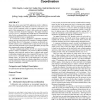1396 search results - page 257 / 280 » Socially distributed perception |
96
Voted
PIMRC
2010
IEEE
14 years 9 months ago
2010
IEEE
Abstract--Is the temporal dimension alone sufficient to characterize contacts in opportunistic networks? Several studies analyze the temporal aspect of contacts with significant re...
WEBI
2010
Springer
14 years 9 months ago
2010
Springer
In this paper, we propose a methodology to predict the popularity of online contents. More precisely, rather than trying to infer the popularity of a content itself, we infer the l...
120
Voted
WWW
2011
ACM
14 years 6 months ago
2011
ACM
The clustering coefficient of a node in a social network is a fundamental measure that quantifies how tightly-knit the community is around the node. Its computation can be reduce...
115
click to vote
CORR
2011
Springer
14 years 3 months ago
2011
Springer
Despite recent advances in uncovering the quantitative features of stationary human activity patterns, many applications, from pandemic prediction to emergency response, require a...
131
click to vote
DEBS
2011
ACM
14 years 3 months ago
2011
ACM
Many data-driven social and Web applications involve collaboration and coordination. The vision of declarative data-driven coordination (D3C), proposed in [9], is to support coord...

